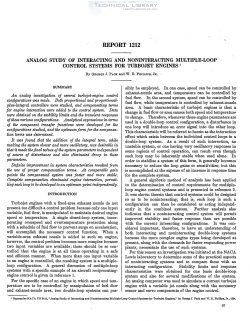naca-report-1212
- Version
- 122 Downloads
- 1.59 MB File Size
- 1 File Count
- November 2, 2016 Create Date
- November 2, 2016 Last Updated
National Advisory Committee for Aeronautics, Report - Analog Study of Interacting and Noninteracting Multiple Loop Control Systems for Turbojet Engines

An analog investigation of several turbojet—engine control
configurations was made. Both proportional and proportional-
plus-integral controllers were studied, and compensating terms
for engine interaction were added to the control system. Data
were obtained on the stability limits and the transient responses
of these various configurations. Analytical eapressions in terms
of the component transfer functions were developed for the
configurations studied, and the optimum form for the compensa-
tion terms was determined.
Itwasfoundthatfieadditionoftheintegralterm, while
making the system slower and more oscillatory, was desirable in
that it made the final values of the system parameters independent
of source of disturbance and also eliminated droop in these
parameters.
Definite improvement in system characteristics resulted from
the use of proper compensation terms. At comparable gain
points the compensated system was faster and more stable.
Complete compensation eliminated engine interaction, permit—
ting each loop to be developed to an optimum point independently.
Turbojet engines with a fixed-area exhaust nozzle do not
present too difficult a control problem because only one input
variable, fuel flow, is manipulated to maintain desired engine
speed or temperature. A single closed-loop system, incor~
porating overspeed and overtemperature protection along
with a schedule of fuel flow to prevent surge on acceleration,
will accomplish the necessary control function. When a
variable-area exhaust nozzle is added to such an engine,
however, the control problem becomes more complex because
two input variables are available; these should be 50 con-
trolled that the engine is at. all times operating in a safe
and efficient manner. When more than one input variable
to an engine is controlled, the resulting system is a multiple-
loop configuration. A general discussion of multiple-loop
systems with a specific example of an aircraft reciprocating-
engine control is given in reference 1.
| File | Action |
|---|---|
| naca-report-1212 Analog Study of Interacting and Noninteracting Multiple Loop Control Systems for Turbojet Engines.pdf | Download |

Comment On This Post